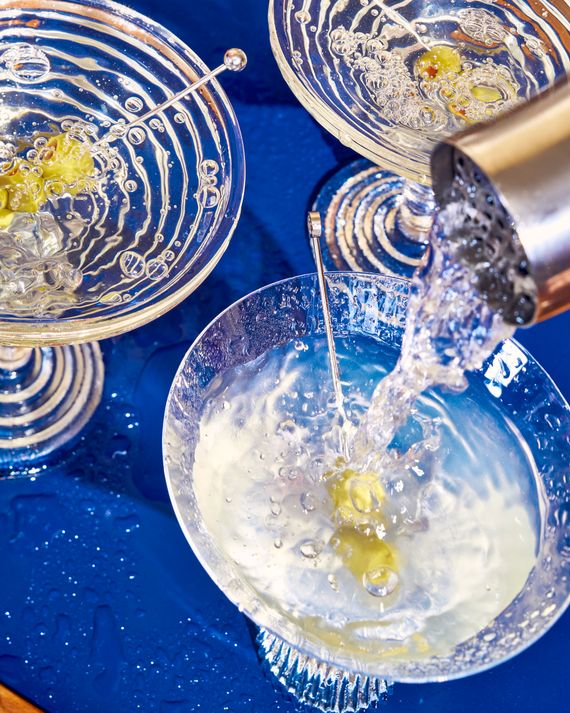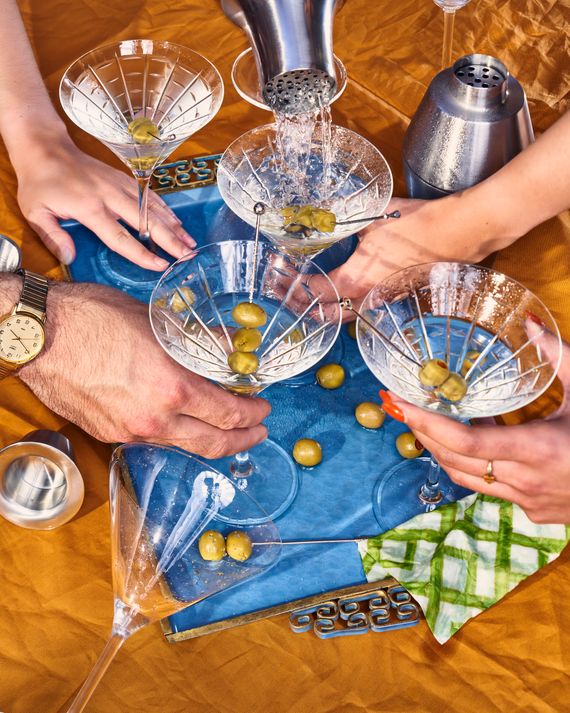
This article was featured in One Great Story, New York’s reading recommendation newsletter. Sign up here to get it nightly.
I’ve been attending quite a bit of theater over the past few months, and thankfully it’s not because I have friends who went to Tisch. Instead, the performance I’ve seen is the carefully rehearsed sound of martini orders followed by the tang of metal cards on bars and tables across New York City. And the more I see it, the more I realize that something interesting happened between the sober-curious boom of last summer and the vodka-laden, cigarette smoke-filled lines that have been forming outside of New York’s bars and restaurants this spring.
Historically, martinis are a drink of gravitas for me, conjuring images of tailored suits, men with money clips and thick stacks of cash, or my dad after work at the bar of a Chinese restaurant waiting for our family’s takeout order. But the martini culture I’ve been observing recently looks nothing like this. I’m talking about tables of friends around burgers and French fries, sloshing back martinis in front of the flash of phone cameras. Twenty-somethings ordering another round at happy hour (a death wish, if you ask me). Massive batched martinis at spring kickbacks (another death wish). “Ordering a martini” has become an activity, something that someone does as much as something that someone drinks.
“You are not wrong about this martini thing,” Toby Cecchini, the owner of Brooklyn’s Long Island Bar says. “It caught everybody unaware. In the same way that years ago all these 20-year-olds were ordering old-fashioneds all of a sudden. We went from making four or five of those for older customers a year to every kid across the bar ordering old-fashioneds without any idea of what they were. I was like ‘What the hell is going on?’ and everyone was like ‘Oh, it’s this show Mad Men.’ But where is the martini coming from? Complete blowback from the pandemic.”
Every day, Cecchini gets a printout of the numbers the bar did the night before. For years, it was a battle between the Long Island Gimlet (a light lime drink) and the Dolores Del Rio (a play on a spicy margarita). “Suddenly, six months ago, the martini was wiping everything out. I was like, ‘Oh my God, we did 71 martinis last night? And 36 gimlets?’ I recently turned to my business partner and was like, ‘I guess we’re just a martini bar now.’ I watch these kids hammering martinis and I’m like, good Lord.”
The timelessness of the drink is certainly playing its part in this recent martini boom: Last weekend I was at a house party and met Isabela Weeks, a self-proclaimed party girl and artist who mused on the martini renaissance between sips of a neon-green Celsius energy drink and tequila (it’s all that was left on the bar). “I noticed a shift last year where people were becoming more mindful of their health and wellness, which I suspect was in relation to the pandemic and a widely felt lack of purpose and direction,” she explained. “But now, as nightlife has been restored to its original glory, it seems that once again we have shifted to a period of excess and pleasure-seeking, a ‘no thoughts, head empty’ philosophy of life. We want to be sexy again — go to sexy dinners, kiss our sexy friends, and drink sexy drinks. Or rather, we want to seem sexy.” This resonated, as I myself had been toying with hot-girl mantras in group texts to the point where I debated if it was still a bit, or just my life.
Weeks’s party-girl consensus is as follows: “Espresso martinis have been deemed basic, vodka cranberries trigger war flashbacks to the trenches of Meatpacking, and Cosmopolitans are a dead giveaway that you believe that you are Carrie Bradshaw. Martinis are for people that believe they are Carrie Bradshaw, but have enough sense to be embarrassed by it.”
She adds that a martini order means something other drink orders do not: “I often order martinis around people who I want to believe that I am interesting. And while the drinks exude sophistication, they are pretty boozy, which means that you can get drunk pretty quickly, and it in turn saves money — great for a girl on a budget who wants to give the illusion that she knows the ways of the world.” (Later that night, I ordered a martini at the Nines, where the party had moved, and I delighted in swirling an icy olive around my mouth while people watched. When I woke up the next day, I saw dozens of Instagram Stories from strangers who also ordered martinis that night.)
Martinis are also a move away from the whole natural-wine bonanza of a few years ago, a drink that offered some kind of higher moral imperative of being closer to the land and less processed or whatever. Martinis offer no such sanctimoniousness: “They’re not good for you, they’re just good,” posits chef and entrepreneur Jonah Reider. “A martini is judged on the execution: so impossibly ice cold it’s surprising its not solid, one elegant garnish, dangerously filled to the top of the most inconvenient un-ergonomic glass shape of all time — and preferably with leftover martini sitting in a spillover cup sitting on ice.”
But even the elegance of the classic martini service sometimes takes a backseat. I recently third-wheeled a date with Will Ryan and Emily Schultz, where they showed me a photo of a water bottle of martinis that they served at a party. It both terrified and amazed me.
“I think coming out of the pandemic there was this idea that we were going to somehow reinvent social interaction because we hadn’t seen each other for so long,” Ryan, a beverage professional, told me. “Wellness culture thrives online and not in the real world, where people are stressed and want an actual escape that is not their Calm App.” A lethal martini is the perfect antidote: “It’s everything that we weren’t raised on: It’s salty, savory, and able to get you shit-faced, quick. This is such an escape from the sweet alcoholic drinks of our past and the seltzers of pre-pandemic.”
In times like these, I call Al Culliton, a writer and cocktail historian based in Massachusetts. “You’re right, martinis are everywhere right now!” they told me. “The martini is similar in its iconic status to New York itself — when you think of either, dozens, nay hundreds, of images swirl in your mind. But how historically accurate are the images? The answer is that it doesn’t matter! It’s just as interesting to understand how history is perceived as it is to actually know the ins and outs of a historical period.”
This overall sense of yearning, for a supreme romance with New York or anything else, is something I’ve observed recently as well. I find people in my world are discovering life is more malleable than they once thought, which can result in surprising life decisions, like breakups or converting to Catholicism or getting plastered on martinis on a Wednesday because we’re all still working from home and we can just turn off the camera on Zoom.
“I think it is a perfect pressure valve for everything people are feeling,” Cecchini predicts. “Everywhere you look you see war, you hear ‘keep your mask on,’ or ‘don’t keep your mask on’ — people are tired of toeing lines. They’re just like, ‘Give me something that transgresses the bounds.’” Cecchini, too, knows that ordering a martini is an attempt to capture some sort of classic romance: “The martini harkens back to so many things that were so solid and representationally correct. You don’t have to think about it. It’s a big solid punch in the face and sometimes that’s just what you need.”





